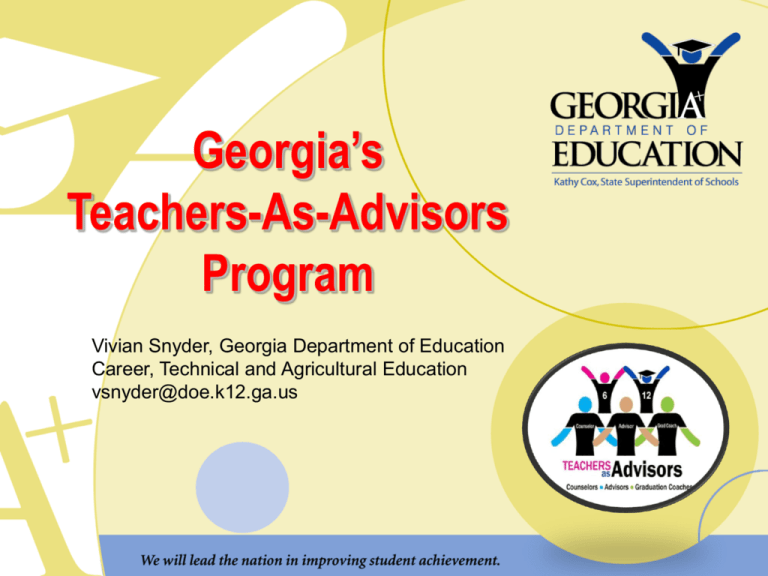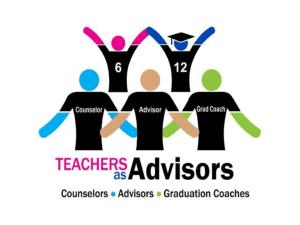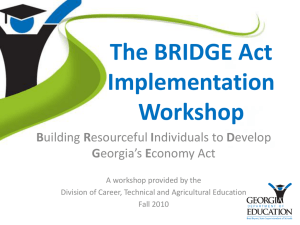
Georgia’s
Teachers-As-Advisors
Program
Vivian Snyder, Georgia Department of Education
Career, Technical and Agricultural Education
vsnyder@doe.k12.ga.us
IT’S A QUESTION OF:
How many opportunities do ALL Georgia students have to explore the
world of work? To understand the connection between school work
and their future career? To assess their individual interests and
aptitudes? To assess their work values and preferences? To assess
their individual learning, collaboration, and problem-solving styles? To
develop a plan of action to reach their educational and career goals?
The New 3 R’s
Rigor
Relevance
Relationships
What is Teachers-As-Advisors?
A systemic, systematic method of delivery wherein an entire student
population (grades 6-12) is assigned, in small groups, to a
trained, caring adult advisor who both advocates for his or her
advisees and facilitates sessions focused on:
1)
Career Management: Awareness, Exploration, and
Planning
2)
Academic Achievement, Educational Attainment and
Lifelong Learning: Thinking and Learning Skills
3)
Life Skills: Personal and Social Development
The TAA 10-Step Process…
1- Establishing Need and Gaining Awareness of Data
2- The Educational and Career Planning Process
3- Articulating a Statement of Purpose
4- Strategic Planning for Parent/Family Involvement
5- Achieving Consensus on Organization and Logistics
6- Designing Framework-Based Content for Delivery
7- Understanding and Fully Utilizing Assessment Results
8- Determining the Level of Leader Involvement and Support
9- Professional Learning and On-going Support
10- Assessing the Effectiveness of a TAA Program
Establishing Need and
Gaining Awareness of Data
“Georgia will lead the nation in student achievement.” Kathy Cox
“Since we live in an age of
innovation, a practical
education must prepare a
man for work that does
not yet exist and cannot
be clearly defined.”
--Peter Drucker
Why Are Student Needs Different in 2008?
Read The World is Flat by Thomas Friedman
In 1957, parents said, “Eat your
dinner; there are children in
India who are starving.”
In 2007, parents say, “Go to
school and learn; there are
children in India who are
starving for your job!”
Facing the Brutal Facts…
Georgia
High School Graduation Rate? A little over 75%
9th
grade retention rate? Too high; overrepresentation of
specific groups of students
Postsecondary matriculation? Poor; sometimes less than 20%
Labor market needs? Skills shortage; Labor shortage
A 2001 study by the National Association of Manufacturers
revealed that 78% of work force representatives believe public
schools are failing to prepare students for the workplace. This
represents little change from similar 1991 and 1997 surveys
administered by the agency, despite a decade of various education
movements.
Parental
involvement? Very little; low level of authenticity
Anonymity of students? Yes, we have students we don’t really
know
“Georgia will lead the nation in student
achievement.” K. Cox
Face the Facts!
Ask yourselves…
•What are the high-skill, high-demand, high wage
jobs identified for your county or region by the
Georgia Department of Labor, the Governor’s Office
of Workforce Development, etc.
•What are the programs of study offered at your
local high schools?
•Are the two aligned? Will they lead your students to
high-skill, high demand, and high-wage careers?
Resources for Establishing Need and
Gaining Awareness of Data
• Georgia Department of Labor/Georgia Labor Market Explorer
http://www.dol.state.ga.us
http://explorer.dol.state.ga.us
• Occupational Supply and Demand System
http://test.occsupplydemand.net/OSD_Main.aspx
• One Georgia Authority
http://www.onegeorgia.org/coi.html
• Partnership for 21st Century Skills
http://www.21stcenturyskills.org/
The Educational and
Career Planning Process
#1-Who Am I?
•GACollege411 including O* Net Interest Profiler
•EXPLORE, PLAN, ACT (Work Keys)
•PSAT
•Armed Services Vocational Aptitude Battery(ASVAB)
•Other: (locally determined) Georgia Career Information System,
Kuder, Career Cruising, COIN, etc.
#2-Where Am I Going?
•Georgia Teachers-As-Advisors Framework and Activities
•O*Net; careerclusters.org; OOH; Career Voyages (USDOL and USDOE)
•Career Centers - Knowledge, Resources, Materials, and Tools
•Labor Market Information – DOL/Georgia Explorer
•Work-Based Learning (MS and HS)
•GACollege411 – Career Planning
•Georgia Career Information System
#3-How Am I Going To Get There?
•Peach State Portfolio: with the Peach State
Pathway: Program of Study
http://www.gadoe.org/ci_cta.aspx?PageReq=CICTA
Career
•Electronic Portfolio System: Through an enhanced
GAcollege411.com and the Georgia Career
Information System (GCIS)
Articulating a Statement
of Purpose
Program Purpose:
Specific purposes your advisory program be designed to meet:
Program Purpose
Priority Value
- Essential, nonnegotiable
- Important, but
negotiable
- Experimental and
negotiable
Addresses
students’ needs in
what ways?
Reflects the needs
of the community
in what ways?
- All students?
- Subgroups?
Finally, write a statement of purpose and create a framework for your advisory
program. Refer to other parts of this document, GADOE resources, Breaking
Ranks II, Breaking Ranks in the Middle and other potential resources.
“Georgia will lead the nation in student
achievement.” K. Cox
Jefferson County School System
Teachers-As-Advisors Statement of Purpose
The mission of the Jefferson County School System Advisor-Advisee
Program is to ensure high levels of student achievement through the
following:
providing a caring, trained adult advocate;
establishing regular communication and an effective link between home and
school;
advising students about academic decisions and monitoring academic
achievement;
creating, facilitating, and guiding movement toward a career concentration so
that each child will be postsecondary ready; and
facilitating seamless academic and social transitions across grades and
schools for students and their families.
Strategic Planning for
Parent/Family Involvement
Strategic Planning for Parent/Family
Involvement
•How do we create parent and family
involvement that is systemic, systematic
and authentic?
•What are the “value-added” elements
of parent and family involvement in the
Teachers-As-Advisors process?
Strategic Planning for Parent/Family
Involvement
Basic indicators for “the relationship”:
Friendly, helpful environment
Genuine concern
Communication, communication, communication!
Viewing parents as partners!
At the least an annual review of student progress in the
spring of each year
Achieving Consensus on
Organization and Logistics
People and Size
How many advisees will each advisor have?
Which adults in the school will serve as advisors? What characteristics should
they possess?
If some teachers do not serve as advisors, what supportive roles can they take
on? Will any advisories be co-facilitated?
By what criteria will the students be divided into advisory groups?
By what criteria will individual students be paired with advisors?
Will advisors and advisees be looped (paired for their tenure in the building)?
What, if any, exceptions would there be to that rule?
What will be the specific roles and responsibilities of advisors?
How will parents be included and involved in the advisory process?
How will business and community volunteers be included and involved in the
advisory process?
Effective Practices: People & Size
Consider one (1) advisor to 12-18 student advisees (average)
Come to consensus on all adults? only certified staff? Who will serve as advisors?
Co-facilitate advisories in working with students with disabilities (create 2 small advisee
groups and pair 2 advisors (one reg. ed and one spec. ed); this allows for inclusion of
SWDs, with the option of utilizing advisory time to, occasionally, review IEP progress).
Match advisors-advisees based on interests, advisor-strength/ student need(s),
personalities, etc. – anything but the “alphabet” method!
“Loop” advisors-advisees for a student’s duration in the building- The longitudinal
relationship and the knowledge it yields are the powers of TAA!
Utilize a rubric to define and assess roles and responsibilities of advisors.
Connect with parents through on-going communication, establishing the advisor as the
central contact point at the school, and increased conferencing.
Business and community partners are an invaluable resource in advisement, especially
in the career and workforce development components.
Time and Space
How often will advisories meet (daily, weekly, monthly, etc.)?
How long will advisory meetings be (brief check-ins, longer
activity periods- ideally, both are needed)?
Will there be time for individual meetings as well as group
meetings?
How will this time fit into the master schedule?
Where will advisories meet?
How will advisories be able to personalize their space?
Will each advisory have its own space?
Effective Practices: Time & Space
Hold a minimum of two advisory sessions per month; however, more frequent
meetings of a shorter duration are equally as effective.
Look for informal ways to connect with advisee between advisory sessions (ex.look for a face-to-face connection with each advisee 2-3 times per week…perhaps
simply saying “hello” in the hall or cafeteria).
Consider a blend of brief check-ins, longer activity periods; ideally, both types of
sessions are needed.
Allow for meetings with individual students, as well as the regular small-group,
advisory meetings.
Advisement is easily scheduled in middle and high schools. Consider the creation
of a standing period that allows for “extra-help” and/or enrichment; advisement is
an appropriate, additional use of that time.
Flexibility is a key element when considering meeting space for advisory groups…
students just need a comfortable place!
Student Involvement/Ownership
What role will students take in creating/overseeing the advisory
program?
How can advisories in grades 6-12 serve as a vehicle for raising
graduation rates?
How can advisories in grades 6-12 serve as a vehicle for raising
student achievement?
How can advisories in grades 6-12 serve as a vehicle to facilitate
more students pursuing post-secondary study?
How can students in the upper-grade advisories mentor students
in the lower-grade advisories?
Effective Practices:
Student Involvement/Ownership
Create a TAA advisory committee made up of students to gain students’
perspectives on the total advisement program and its processes.
Give students (grades 6-12) a voice in considering the following:
-How can advisories serve as a vehicle for raising graduation rates?
-How can advisories serve as a vehicle for raising the rigor of core academic
studies and student achievement?
-How can advisories serve as a vehicle for leading students to a focused area
of study in high school?
-How can advisories serve as a vehicle to facilitate more students pursuing
post-secondary credit opportunities (during high school) and post-secondary
study (after graduation)?
Create structures for students in the upper-grade advisories to mentor
students in the lower-grade advisories.
Designing FrameworkBased Content for Students
Designing Framework-Based Content for
Students
Use the Georgia TAA Framework to gather
materials and develop TAA sessions
• TAA Framework may be found at
https://www.georgiastandards.org/Resources/Pages/Tools/Teacher
s-as-Advisors.aspx (GSO)
• See Teachers-As-Advisors video module #6, to view a group
actually creating an advisement session:
https://www.georgiastandards.org/Resources/Pages/Tools/Teacher
s-as-Advisors.aspx (the video link will also connect through GSO)
GSO: Online Resource Link
Georgia Teachers-As-Advisors Framework
January 2008
Kathy Cox, State Superintendent of Schools
Georgia Department of Education, All Rights Reserved
GSO: Video Modules
http://www.gpb.org/educationconnection/ professionallearning/teachers-as-advisors
Understanding and Fully
Utilizing Assessment
Results
Understanding and Fully Utilizing
Assessment Results…
the missing link…
Understanding and Fully Utilizing
Assessment Results
• Draw from multiple assessment resources to gain a
comprehensive look at each individual student (strengths,
interests, aptitude, work values and preferences).
– State Assessments (CRCT, EOCT, GHSGT, etc.)
– Explore, PLAN, ACT, PSAT, SAT, etc.
– GAcollege411 O* Net Interest Profiler, O*Net Work
Importance Locator
– Armed Services Vocational Aptitude Battery (ASVAB)
– Other Interest, Aptitude, and Work Values and Preferences
assessments
Determining the Level of
Leader Involvement and
Support
Determining the Level of
Leader Involvement and Support
Who will champion Teachers-As-Advisors
in your district or school?
Principal responsibilities
Advisor responsibilities
Counselor and/or Graduation Coach responsibilities
Barriers and challenges and how to address them
Professional Learning and
Continued Support
Professional Learning and
Continued Support
Develop a professional learning plan to
include:
• Informational sessions
• Skill Building sessions
• Continued Support
• regular feedback-what works!
• incentives-help me!
• results data- Is this work paying off?
Professional Learning/Support
How do we create regularly scheduled time for advisors to meet with students
(coordination with the academic calendar and time for training, curriculum
development, sharing successes)?
In what types of configurations can advisors meet for training and support
(clusters, teams, full faculty, pairs)?
How will we identify the types of training and support advisors need (academic
advising, how to communicate with parents, listening skills, knowing when to
refer advisees to others, etc.)?
How will the initial training be conducted and by whom?
What resources will advisors need? Will these resources be readily available?
What ongoing support will be provided after initial training?
How will advisors be observed and assessed?
Effective Practices:
Professional Learning/Support
Because advisement is best implemented at the district level, form a district-level TAA
Focus Team that is made up of school-level focus teams. A school-level focus team
should be made up of (5-7 members):
- the principal (or his/her administrative designee
- counselor(s) and/or graduation coach(es)
- teachers who are skilled at building relationships with students
- teachers who are knowledgeable of career development
- teachers who may be skeptical of the value of advisement
Building leaders must protect time scheduled for advisement.
Consider holding sessions for TAA training and support during the school day (planning
periods) and forming additional support structures (clusters, teams, pairs) for teacheradvisors.
Identify the types of training, resources, and support advisors need through information
gathered from teacher-advisor surveys, student surveys, post-advisement reflections,
and observation of advisory sessions.
Assessing TAA Program
Effectiveness
Assessing the Effectiveness of a
Teachers-As-Advisors Program
• Data-driven Outcomes (programmatic measures, advisor
effectiveness, student satisfaction, parent satisfaction, etc.)
-What kinds of data / how will you gather data to measure
outcomes? Graduation; retention; behavioral referrals; # of students
taking higher level courses; pathway selection
• Rubrics
-How will you develop rubrics and hold each participant in
the process accountable?
Assessing Your Teacher-Advisors
EVALUATING YOUR TEACHERS-AS- ADVISORS (TAA)
PROGRAM (OK)
ADVANCED
PROFICIENT
BASIC
DEVELOPING
(Majority of criteria
checked in each
section)
(Minimum of 3
criteria checked in
each section)
(Minimum of 2
criteria checked in
each section)
(Must have at least 1
criterion checked in
each section)
56-66 Points
41-55 Points
26 – 40 Points
11- 25 Points
NOT YET
ESTABLISHED
(No criteria checked
in one or more
sections)
0-10 Points
Advanced
Your TAA program is well established. Continue to review and self-evaluate after every
session and make required adjustments as needed to continue to help students be
successful.
Proficient
Your TAA program has engaged the majority of your school’s staff, students and parents.
The TAA activities are varied and supportive of students’ goals. Continue to challenge
yourselves to find additional ways to provide students the opportunity to develop skills
they need for future success.
Basic
Your TAA program is meeting the standard. Continue to meet on a regular basis with your
advisory committee, encourage staff participation, and seek feedback from students and
parents to help make progress in what you’re doing.
Developing
Your TAA program is in the development stage. You most likely have been working hard
to develop a program in which everyone is actively involved. You feel frustration because
not everyone views it as their job to assist students in planning for their future. Continue to
seek administrative support, train staff on a regular basis and seek community assistance.
Not Yet
Established
Seek assistance because your TAA program may need improvement or you have not
worked to develop and implement a TAA program.
Implementing TAA
•
Teachers-As-Advisors is BEST implemented at the DISTRICT level by a
TEAM of professionals. In a very large district, this can be done by MSHS feeder patterns.
•
The district-level TAA Focus Team should be made up of its schoollevel focus teams. A school-level focus team should be made up of (5-7
members):
– the principal (or his/her administrative designee)
– counselor(s) and/or graduation coach(es)
– one or more teachers who are skilled at building relationships with
students
– one or more teachers who are knowledgeable of career
development
– one or more teachers who may be skeptical of the value of
advisement and have a need to be a part of the development
www.gadoe.org/ci_cta.aspx
Thank you for attending!






